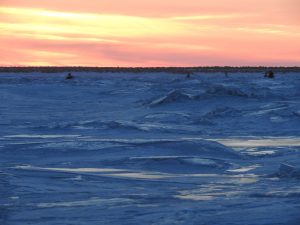Off the road system. For years, that phrase cast a seductive mystique I had not felt since my early traveling days. At 23, I moved four thousand miles from my childhood home in the Chicago suburbs to Denali National Park, Alaska, and although there was an entire country wedged between the two locations it was entirely feasible to drive from point A in Illinois to point B in Alaska. In fact, I’ve done it several times now. After arriving at the park entrance, one could catch a bus and continue west another 90 miles into the a park the size of Massachusetts, and find themselves about as far west as a person can possibly navigate by way of the veinous road system that meanders across North America. I spent my college years in Boston, and packed quite a bit of fun into the small New England state’s capital city. Yet, you can fit 25 Massachusettses into the state of Texas, and squeeze 2.5 Texases into the state of Alaska — the majority of which exists beyond the road system — so how big is that park really?
Denali was the buffer between the connected world I had known, and the unknown. The Western world presses against the edge of this road system — a force that’s already enveloped most of the continent — yet something raw still exists on the other side even as televisions reach more homes and snowmachines replace sled dogs. I had traveled so far, and yet I hadn’t cut the umbilical cord of that continental road system. I wondered, what does life look like beyond the edge of Denali Park? How important is community? Is there true wilderness or is that concept even possible when people have always lived in and traveled the roadless landscape?
Almost a decade later, Iditarod provided me a keyhole of insight into life off the road system — something I’m continuing to learn the meaning of today. As I look forward to my third year working with Insider, the aspect that surfaces in my memories is the people. These villages open their communities to Iditarod vets, volunteers, media, and, of course, the teams. They are more than just checkpoints; for generations, sled dogs were the fabric that wove these communities together and made life in the interior and coastal plain possible. With rich histories of hunting, running traplines, and exploring the landscape with dogs, these communities are the backbone of this lifestyle-turned-sport, and it is their welcomeness and volunteerism that continues to make this race possible today. From locals to out-of-state volunteers, this race boasts a strong history of people working together.
Over the next thousand miles, I intend to share with the Iditarod community some of these stories. Many of us who have supported the race through Insider subscriptions have not had the opportunity to experience the trail firsthand. This is an opportunity to give back to the people who make this race possible, including Insiders like you. From locals who open up their communities, to volunteers from both in and out of state, to vets who take time from their practices to put dog care first in this event, this mosaic illustrates the story behind the race, and gives shape to life off the road system.
For more from the Insider team, subscribe here to access pre-race interviews with the mushers and be the first to see footage from the trail!


































